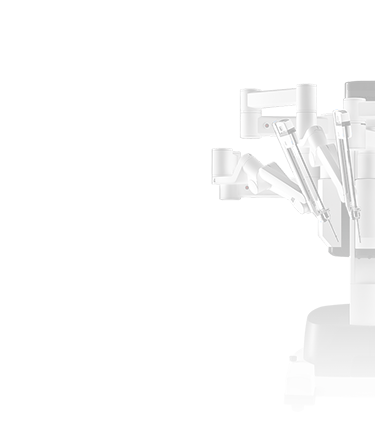The choice of the method of treatment of colorectal cancer depends on the degree of advancement of the cancer. In most cases, the choice method is surgical treatment which involves the necessity of removing the tumour together with a section of the bowel. Depending on the degree of advancement, the procedure can be performed by means of colonoscopy (in the very early stages), laparoscopy, also using the robot, or laparotomy.
Types of procedures:
- right hemicolectomy – resection of the right side of the colon, performed for cancer of the caecum or the ascending colon
- left hemicolectomy – resection of the left side of the colon, performed for cancer of the descending colon and some cancers of the sigmoid colon
- total colectomy – resection of the entire colon
- sigmoidectomy – resection of the end section of the colon, i.e. the sigmoid colon (with or without a resection of the rectum)
PREPARATION FOR THE SURGERY
Patients in the pre-, peri- and post-operative period are under the care of an interdisciplinary team consisting of a surgeon an anaesthesiologist, a psychooncologist, physiotherapist and dietician as well as other specialty doctors depending on the overall health status. The necessary preparations include assessment of full blood count and blood smear and of kidney function as well as cross-matching.
Particular attention is given assessment made by anaesthesiologists and other specialist of patients with respiratory and respiratory diseases as well as those suffering from congestive heart failure and valvular insufficiency due to the increased risk of complications in their cases.
The anaesthesiologist starts perioperational antithrombotic therapy. Depending on the patient’s overall condition, they may also be assisted by other specialist in order to put in place the optimal pharmacological procedure.
The psychooncologist supports patients with cancers as well as their loved ones during the whole journey through the disease. They may also assist in minimising the adverse mental effects that the patient and his family experience in connection with the disease as well as in building a system of support to the patient, both internal (sense of worth, optimism, creativity and sense of humour) and external (family, significant others, friends and fellow workers). They also provides instruction on how to transform the attitude and thoughts that have a weakening effect on the patient and on reducing techniques, such as visualisations, relaxation or breathing exercises.
The physiotherapist works with the therapy and functional assessment of the pelvic floor and the overall condition of the patient. Physiotherapy used before and after the surgical intervention enables appropriate preparation for the procedure and maintaining its effects. Rehabilitated patients have a faster recovery rate with regard to the sexual function and urinary continence. Appropriate physiotherapy on the day of the procedure prevents complications in the form of pneumonia and venous thrombosis.
Of great importance for the recovery after cancerous diseases or extensive surgical interventions is correctly balanced nutrition. Therefore, the therapeutic team includes a dietician.
THE PROCEDURE
The procedure is performed in general anaesthesia. At the beginning of each operation, the so-called pneumoperitoneum is produced by filling the abdominal cavity with carbon dioxide in such a way as to obtain a convenient space in which to manipulate the instruments by elevating the abdominal walls from inside and pushing aside the intestines. Then the surgeon makes a few small abdominal incisions in order to introduce the arms of the robot which are equipped with surgical instruments with a small diameter and a camera. In most laparoscopic procedures the surgeon operates through 3 or 4 such incisions (1 cm). In some cases one of the incisions is enlarged (to 5-7 cm) in order to complete the surgical procedure or remove the affected organ from the abdominal cavity. The surgeon uses a 3D HD vision system which ensures an enlarged view of the patient’s tissues. The image is transmitted to the console and the surgeon performs the procedure while looking at the display and viewing the interior of the abdominal cavity and enlarged views of the individual organs. The robotic system translates all hand movements into smaller, precise movements of the small instruments in the patient’s body. Finally, the removed tumour or organ is placed in a special bag and taken outside, and then it is sent to a pathology laboratory for careful examination in order to determine the degree of malignancy and the nature of the lesion (the final report from the examination is usually available after 14 days). This method enables performing surgeries without the necessity of the classical opening of the abdominal cavity, reduces postoperative pain complaints, promotes faster recovery and causes fewer infectious complications of the postoperative wound, and also guarantees a better cosmetic effect.
BENEFITS FOR PATIENTS
The robotic system is a better tool as compared with the classical or laparoscopic access, for dissecting and removing lymph nodes and providing protection of the autonomic nerves during oncological procedures. Robot-assisted surgery provides urologic oncologists with the possibility of performing minimally invasive, precise and complete procedures with good oncological clearance.
In comparison with procedures performed using the classical or partly laparoscopic methods, the use of a robot enables:
- over two-fold higher likelihood of retaining potency
- lower probability of biochemical recurrence
- fewer number of complications
- reduction of postoperative pain
- reduced blood loss
- better cosmetic effect
- shorter stay at hospital
- faster return to the daily routine and professional life

 +48 785 054 460
+48 785 054 460 










